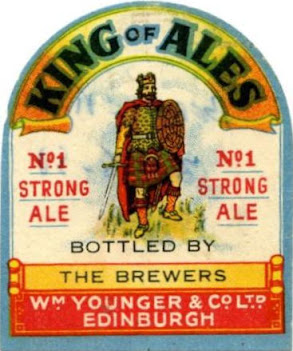That William Younger introduced a new top of the range beer when gravities fell is a sign to me that the name really reflect the wholesale price.
160/- is a very powerful beer, with an OG even a little higher than 1859 140/-.
Not much to the recipe again. Just base malt and sugar. There are two types of sugar, DM and “sacch.”. I’m guessing that the latter is some sort of invert. But I could be wrong. “Saccharum” really just means sugar. I’ve gone with No. 1 invert.
Hops from both continental Europe and the USA again: Kent from the 1887 and 1888 seasons, Wurttemberg from 1887 and American from 1887 and 1888.
| 1888 William Younger 160/- | ||
| pale malt | 23.50 lb | 90.38% |
| maltodextrin | 1.25 lb | 4.81% |
| No. 1 invert sugar | 1.25 lb | 4.81% |
| Cluster 120 min | 3.00 oz | |
| Tettnanger 60 min | 3.00 oz | |
| Fuggles 30 min | 3.00 oz | |
| OG | 1118 | |
| FG | 1042 | |
| ABV | 10.05 | |
| Apparent attenuation | 64.41% | |
| IBU | 84 | |
| SRM | 9 | |
| Mash at | 150º F | |
| Sparge at | 163º F | |
| Boil time | 120 minutes | |
| pitching temp | 54º F | |
| Yeast | WLP028 Edinburgh Ale | |













































































6 comments:
Why the long boils, though?
- Because they tried to extract as much sugar from their mash as possible, and so had to evaporate a whole lot of water?
- For the taste?
- To obtain a high IBU?
Was the Maltodextrin there for Brett? Had they worked out explicitly that Maltodextrin worked as food for a second round of fermentation in 1888, or would this just be intuition?
10% ABV and 84 IBH sounds undrinkable.
I assume the recipe is for 5gal--is that correct?
InSearchOfKnowledge,
2 hours isn't particularly long for the late 19th century.
Anonymous said,
yes, I think the Maltodextrin was there for a Brett secondary fermentation.
10% ABV and 84 IBU is what the yoof nowadays call a double IPA.
Post a Comment